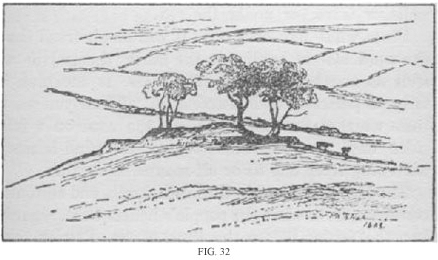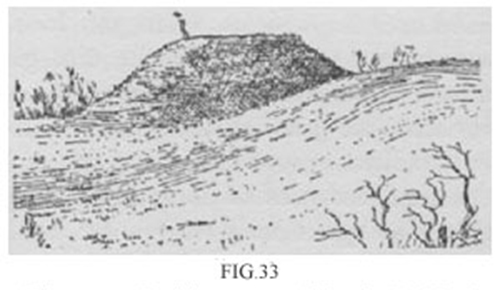Irish Shee or Fairies
From A Smaller Social History of Ancient Ireland 1906
« previous page | contents | start of chapter | next page »
CHAPTER V....continued
Shee or Fairies and their Dwellings.—The pagan Irish worshipped the side [shee], i.e. the earth-gods, or fairies, or elves.
These side are closely mixed up with the mythical race called Dedannans, to whom the great majority of the fairy gods belonged.
According to our bardic chroniclers the Dedannans were the fourth of the prehistoric colonies that arrived in Ireland many centuries before the Christian era.
They were great magicians, and were highly skilled in science and metal-working.
After inhabiting Ireland for about two hundred years, they were conquered by the people of the fifth and last colony—the Milesians.
They then arranged that the several chiefs, with their followers, were to take up their residence in the pleasant hills all over the country—the side [shee] or elf-mounds—where they could live free from observation or molestation; and Bodb Derg [Bove Derg] was chosen as their king.
Deep under ground in these abodes they built themselves glorious palaces, all ablaze with light, and glittering with gems and gold.
Sometimes their fairy palaces were situated under wells or lakes, or under the sea.
From what has been said it will be observed that the word side is applied to the fairies themselves as well as to their abodes.
And shee, as meaning a fairy, is perfectly understood still.
When you see a little whirl of dust moving along the road on a fine calm day, that is called shee-geeha, ‘wind-fairies,’ travelling from one lis or elf-mound to another.
The ideas prevalent in the ninth, tenth, and eleventh centuries, as to what the people's beliefs were, regarding the fairies before the time of St. Patrick, are well set forth in the concluding paragraph of the tale of “The Sick Bed of Cuculainn” in the Book of the Dun Cow:—
“For the demoniac power was great before the faith: and such was its greatness that the demons used to tempt the people, and they used to show them delights and secrets, and how they might become immortal. And it was to these phantoms the ignorant used to apply the name side.”
Numbers of fairy hills and sepulchral carns are scattered over the country, each with a bright palace deep underneath, ruled by its own chief, the tutelary deity. They are still regarded as fairy haunts, and are held in much superstitious awe by the peasantry.
The fairies possessed great preternatural powers. They could make themselves invisible to some persons standing by, while visible to others: as Pallas showed herself to Achilles, while remaining invisible to the other Greeks (Iliad, 1.).
But their powers were exercised much oftener for evil than for good.
They were consequently dreaded rather than loved; and whatever worship or respect was paid to them was mainly intended to avert mischief.
It is in this sense that they are now often called ‘Good people.’
FIG. 33. Fairy moat at Patrickstown, near Oldcastle, Co. Meath (From Journ. Roy. Soc. Antiq. Irel., 1898)
They could wither up the crops over a whole district, or strike cattle with disease.
To this day the peasantry have a lurking belief that cattle and human beings who interfere with the haunted old lisses or forts, are often fairy-struck, which brings on paralysis or other dangerous illness, or death.


